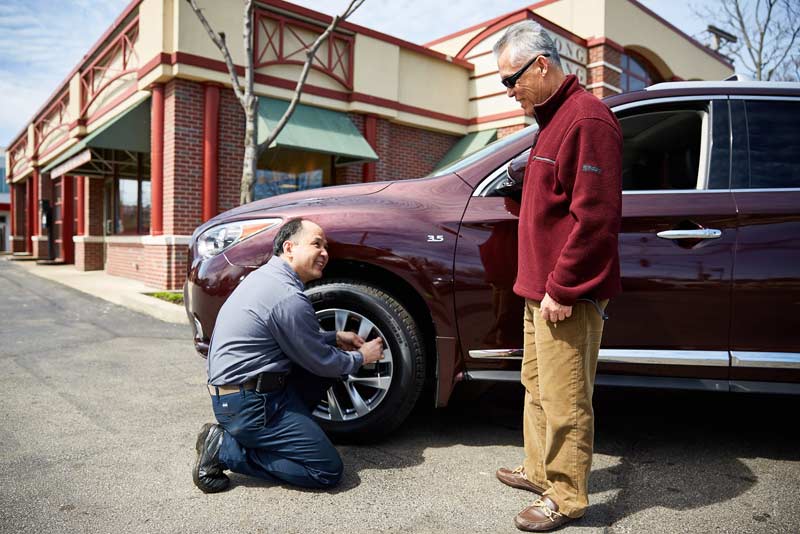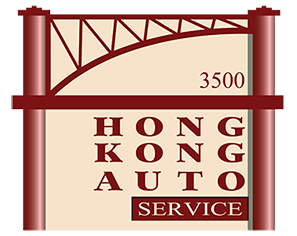Why Tire Pressure and the TPMS Matters
 OK, we get it. Tire pressure is BORING. Unless the tire is flat, who cares, right? And that tire pressure warning light on the dash: It will go away sooner or later, won’t it?
OK, we get it. Tire pressure is BORING. Unless the tire is flat, who cares, right? And that tire pressure warning light on the dash: It will go away sooner or later, won’t it?
While tire pressure may not be the most fascinating subject in your day, it matters more you realize. Especially if the tire pressure warning light has come on.
Why Tire Pressure Matters
Keeping the tires on your vehicle inflated to the recommendations of the car manufacturer will not only make the tires last longer, but it will help to keep you and your passengers safe.
Underinflated Tires
Low tire pressure increases the amount of time and distance it takes your car to brake. If you have ever slammed on the brakes and stopped just inches short of the other car, you will realize how important those small distances can be. Having the tires properly inflated can mean the difference between missing and hitting the other vehicle.
Another factor to consider is that low tire pressure allows the sidewalls on the tire to flex more. More movement means that the tire creates more heat due to friction. Moderate amounts of heat will simply cause your tires to wear out faster. You don’t mind spending money on a new set of tires, right? Even worse, a large amount of heat from the tires can cause the tire to blow. The faster you are driving, the more heat the tire is generating. Blowouts that occur when you are driving very fast can cause you to lose control of the vehicle.
Last, but not least, tires that are underinflated reduce gas mileage. While it may not be enough for you to really sit up and take notice, why would anyone want to pay for than they need to for gas? All it takes is a simple check of the pressure in your tires every now and again.
Overinflated Tires
We focus more on underinflated tires because they can lead to accidents. Overinflated tires aren’t as problematic, but they still aren’t a good thing.
Most modern-day tires can withstand being overinflated. It gives you a harsher ride, which you may or may not notice. However, consistently driving with overinflated tires will quickly wear out the tread in the center of the tire. Tires can be expensive, and no one wants to spend money on new tires any sooner than necessary.
Older Model Vehicles
If you have an older model car that lacks a tire pressure monitoring system (TPMS), you will need to check the tire pressure yourself. You can usually find a tire shop or mechanic to check the tire pressure for you. Although, it’s much easier to do it yourself rather than finding someone willing to check out your car.
Buy a tire pressure gauge at any auto parts store or department store. Don’t rely on the gauges at gas stations as they tend to be horribly inaccurate. A tire pressure gauge will cost you about $5 and it’s a worthwhile investment.
Look at the plate on the driver’s door or the pillar. This plate should list the tire size and the maximum or suggested air pressure for your tires. You can also consult your owner’s manual.
For best results, check the tire pressure once a month.
The only trick here is that you need to check the tires when the car has been sitting for several hours and not drive it more than 3 or 4 miles. This is called cold tire pressure. The air pressure in the tire will increase by a few pounds as the tires heat up. You want to know the cold tire pressure number. Once the tires are warm, the pressure can increase between 2 and 6 PSI (pounds per square inch).
If you are lucky, you live close to a gas station. You check the tire pressure in the morning before you leave home and if they need air, you drive down to the gas station and put in the necessary air that the tire(s) need.
If you aren’t lucky and don’t live close to a gas station, it might take you several trips to get it right. Measure the tire pressure, note how much the tire needs (for example, 5 PSI). Put in 5 PSI at the gas station according to their gauge.
You won’t necessarily rely on the gauge. For example, if the gauge reads 25, add air until the gauge says 30 (even if you want the final number to be higher). Go home and check the tires again in the morning. Hopefully, you hit the bullseye. Otherwise, repeat until you get it right. This can be a pain, but hopefully it is something that you only need to do once or twice a year. If the tire loses air pressure regularly, it will need to be inspected for a leak.
Newer Models with TPMS
If your vehicle has a TPMS, a light on the dash will tell you when one or more of the tires has low tire pressure. Some car models only tell you that there is low pressure, but it doesn’t indicate which tire. Other models will tell you exactly which tire has the problem.
Again, we recommend using a manual tire pressure gauge to check and, if necessary, adjust the tire pressure.
How to Reset the TPMS Light
Many vehicles will automatically turn off the light when the tire pressure has reached a safe PSI. Others require you to press a reset button. If the light remains on, but you are certain that the tires all have the correct pressure, check the owner’s manual for a reset process. If you don’t see one, try the following steps:
- Look for a reset button under the steering wheel, often located on the steering column itself. Turn the key to the on position, but don’t start the motor. Press the reset button for about 3 seconds or until the TPMS light starts flashing. Release the button and start the car. Drive for about 20 minutes. Turn off the ignition. See if this has solved the problem.
- After you are certain the tires have the proper air pressure, drive the car at 50 MPH for about 10-15 miles. Many sensors will reset themselves once the vehicle sits at this speed for a few miles. Use cruise control to maintain this speed and drive at least 10 miles.
- You could also disconnect the positive battery terminal, but this can cause problems you will find more annoying than the TPMS warning light not going out. (Like the loss of radio station pre-sets, engine stalling, poor engine performance, transmission shifting problems, or the appearance of other warning lights.) Before you go to this measure, stop by Hong Kong Auto Service and ask us for some help!
The Bottom Line
Tire pressure is far more important than most people realize. Keeping everyone safe should be of the utmost importance for every driver. So checking the tire pressure regularly or paying attention to the TPMS warning light should be a priority of every driver.
The TPMS warning light on your vehicle still won’t go out? Aren’t sure how to read the tire pressure gauge? Or, if you have general questions about the tires on your vehicle, trust the friendly staff at Hong Kong Auto Service. We will gladly answer your questions or investigate why the TPMS light won’t turn off. Best of all, you will have the peace of mind knowing that the tires on your vehicle are road worthy and ready to go.
Call or drop by if you want to engage in a little tire talk. The mechanics at Hong Kong Auto Service are always ready to help.
